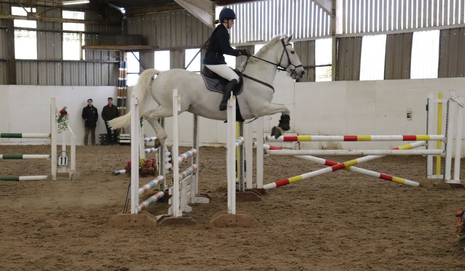A sport in transition: Modern Pentathlon’s new fifth event
Tads Ciecierski-Holmes explores the modernisation of the Modern Pentathlon

A lot has changed in the sport of Modern Pentathlon since I last wrote about Cambridge’s most versatile (and loveliest) athletes. While the facts in this article have not changed in the past four years, the sport itself is undergoing a major transition.
‘Modern’ Pentathlon consists of five disciplines including running, swimming, pistol shooting, epee fencing, and show jumping. An Olympic event since 1912, the sport aims to test the skills you would need as an early 20th century cavalry officer stuck behind enemy lines.
“Scenes like those at the Tokyo Olympics also raised questions about horse and rider welfare”
The delayed Tokyo Olympics pentathlon event showcased the skills, power, and nerve required to excel, with Team GB taking an unprecedented double Gold in the men’s and women’s event. However, this achievement was mired by controversy in the riding phase, when hopeful medal contender Annika Schleu was eliminated after her horse refused to jump the course and her coach was disqualified for hitting the horse during the round.
The controversy added to longstanding concern about the suitability of the riding phase. The format involves showjumping an unknown horse randomly drawn from a pool which each rider has not ridden before. You then have a short warm-up to get acquainted before jumping a course. When all goes well, it is quite a sight to behold the rapid cooperation between a horse and rider. However, the format has been criticised for having too great an element of luck, where scores in the showjumping may reflect the horse’s ability rather than the rider’s. Scenes like those at the Tokyo Olympics also raised questions about horse and rider welfare.
Ultimately, the experience at Tokyo proved a final straw. The international governing body for Modern Pentathlon voted to replace horse riding with obstacle course racing which will first feature at the 2028 Los Angeles Olympics. Pentathletes now have to race through a 70m long Ninja Warrior-style course with monkey bars, rings, balance elements, and a stonking curved wall at the finish. In keeping with the original ethos of the sport, obstacle racing is a discipline requiring skill, agility, and athleticism, thus contributing to the overall versatility of the (now even more modern) pentathlete.
“The introduction of a new discipline is naturally a challenge for athletes to adjust to, but it is something that pentathletes are embracing worldwide”
With obstacle racing having already been introduced for youth pentathletes internationally, the change is bringing in a new cohort from different backgrounds – especially those who could not access or afford equestrian facilities. The 2024 African Nations Championships included obstacle racing and saw a swathe of up-and-coming pentathletes who were able to complete a full pentathlon for the first time.
I had the privilege of meeting the Ugandan Pentathlon Team while in Kampala on my recent medical elective placement. Arnold Kisulo, who is now just a year into his pentathlon career having previously represented Uganda in swimming events, thinks that obstacle course racing is a fairer format that is more accessible. According to Kisulo, “the change makes it easier for every athlete to do their best because the horses at times would be unpredictable” and “it gives athletes more of an opportunity to complete the pentathlon and maximise on their points.” Rashidah Najjuma and Marshall Miiro, who have been competing on the international stage for almost two years now, completed the obstacle course phase for the first time at the African Nations Championships. Najjuma told me that “the obstacle course was really rough because it was my first time to try it out but it was really interesting because of its challenging nature. It gave me a feeling of [being] a complete pentathlete.” The introduction of a new discipline is naturally a challenge for athletes to adjust to, but it is something that pentathletes are embracing worldwide. Miiro added: “Hopefully I can continue to improve and be more sharp and efficient in the obstacle [racing] in future competitions.”
Although obstacle racing certainly improves accessibility over horse riding, there remains a disparity in terms of facilities available to different athletes. Training on competition regulation courses may still be difficult for a lot of athletes given they are not yet widely available. At the Cambridge club we are hoping to use existing obstacle training infrastructure in the local area to provide training opportunities for our members to try out and prepare for competitions. Najjuma highlighted that access to obstacle training facilities is an issue for the Ugandan team and that accessibility “remains a challenge for some developing nations that are still developing the sport without permanent training grounds.”
We will very soon see the last round of Pentathlon horse riding at the Olympics. For better or worse, the sport is transitioning to a new phase that hopes to bring in new athletes. From the perspective of our Cambridge Pentathlon community, we are changing with the times and hope to see the next generation of pentathletes racing through obstacle courses at BUCS and Varsity in 2025 and beyond.
 Music / The pipes are calling: the life of a Cambridge Organ Scholar25 April 2025
Music / The pipes are calling: the life of a Cambridge Organ Scholar25 April 2025 Arts / Plays and playing truant: Stephen Fry’s Cambridge25 April 2025
Arts / Plays and playing truant: Stephen Fry’s Cambridge25 April 2025 Comment / Cambridge builds up the housing crisis25 April 2025
Comment / Cambridge builds up the housing crisis25 April 2025 Interviews / Dr Ally Louks on going viral for all the wrong reasons25 April 2025
Interviews / Dr Ally Louks on going viral for all the wrong reasons25 April 2025 News / Candidates clash over Chancellorship25 April 2025
News / Candidates clash over Chancellorship25 April 2025






